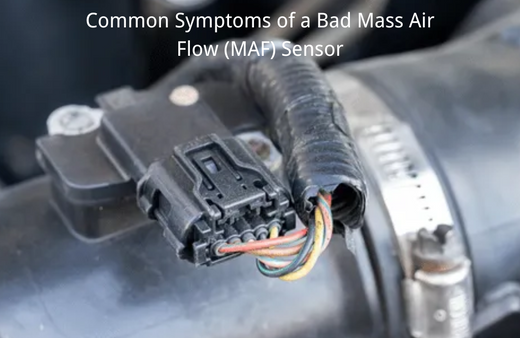If your vehicle is acting strangely, it might be worth inspecting its Mass Air Flow (MAF) sensor for signs of problems; components like this are often overlooked.
Understanding the signs and symptoms of a malfunctioning MAF sensor can save time, money, and hassle. Let's examine some indicators so we can address this problem as quickly as possible.
Engine Stalling or Hesitation
An obvious telltale of an inadequate MAF sensor is when your engine unexpectedly stalls unexpectedly or hesitates upon acceleration, rendering acceleration impossible.
Your car might be experiencing difficulties accelerating or stopping at traffic lights due to its MAF sensor's essential role of measuring how much air enters its engine and maintaining an ideal air/fuel mix, providing optimal performance.
An engine with malfunctioning components does not receive accurate data, leading to performance problems and reduced output.
Poor Fuel Economy
Are you finding that more frequent visits are being made to the gas station? If that is the case for you, perhaps something may have altered its ability to perform efficiently as it should have.
Unineffective MAF sensors may cause your engine to use more fuel than necessary, leading to decreased efficiency in your vehicle and leading to greater consumption than necessary. When receiving incorrect information from this sensor, your engine could respond by increasing fuel intake - further diminishing efficiency levels within it.
Not only can this affect your wallet, but it will also lead to increased emissions.
Check Engine Light is On
Your Check Engine Light (CEL) serves as an early warning that something may be going amiss with your engine, signalling potential trouble that needs immediate attention from you and/or servicing experts. Activation of this indicator usually indicates something is amiss which requires immediate repair action to resolve.
CEL illumination may be caused by an issue with your MAF sensor; disregarding this warning could result in more serious engine issues down the line.
When your Check Engine Light (CEL) illuminates, it is critical that your vehicle be scanned for error codes to ascertain if MAF sensor problems may be the root of its problems.
Rough Idling
A vehicle's smooth-idling engine can often be seen as a sign that its health has improved. When this occurs, however, problems could develop that require repair before being driven away again.
If your car begins idling irregularly or vibrating when in neutral, or has started shaking when stationary, the MAF sensor could be to blame.
Sensors ensure your engine receives an ideal air-fuel mix; any disruption could lead to irregular running patterns or cause it to malfunction altogether.
Difficulty Starting the Engine

The trouble with starting your car can be particularly bothersome during inclement weather conditions and should always be considered an inconvenience.
An inadequate MAF sensor could deprive your engine of sufficient air for starting and smooth running conditions, potentially making engine start up harder or diminishing performance overall. A malfunctioning sensor would make engine starting difficult as well as jeopardize both health and performance of its host engine in general.
Reduced Engine Power
If your vehicle experiences a noticeable decrease in power when accelerating or climbing hills, particularly under acceleration and while climbing hills, then its MAF sensor could malfunction and should be further investigated.
Reduced power is due to insufficient air-fuel mixture being supplied to the engine for peak performance.
Unusual Engine Noises
A malfunctioning MAF sensor could lead your engine to make unusual sounds such as popping and sputtering, leading to strange engine noises such as popping or sputtering noises that make an engine seem off track and off balance. This issue often stems from low oil pressure levels being the root cause when this is combined with unusual engine noises such as popping and sputtering.
These sounds could indicate an engine struggling to achieve proper air-fuel balance and combustion, potentially leading to unpredictable results.
What Happens When the MAF Sensor Fails?
When your MAF sensor malfunctions, it could throw off the delicate balance necessary for efficient engine operation - potentially destabilizing performance considerably and jeopardizing engine health in general.
An imbalance may create various performance problems:
- Incorrect Air-Fuel Mixture: The engine may run too rich (too much fuel) or too lean (too little fuel), both of which can cause damage over time.
- Increased Emissions: An improper mixture can lead to higher emissions, contributing to environmental pollution.
- Engine Damage: Prolonged operation with a faulty MAF sensor can cause damage to other engine components, leading to more expensive repairs.
Diagnosing a Faulty MAF Sensor
Proper diagnosis of an MAF sensor failure involves both observations and technical diagnostics. Here's how you can pinpoint whether it's in your vehicle:
Diagnostic Trouble Codes (DTCs)
When equipped with an OBD-II scanner, you can gain access to specific DTCs indicating issues related to your MAF sensor.
Common MAF sensor codes include:
- P0101 – Mass or Volume Air Flow Circuit Range/Performance Problem: This code indicates that the MAF sensor is sending data outside the expected range.
- P0102 – Mass or Volume Air Flow Circuit Low Input: This code signifies that the MAF sensor is reporting a lower-than-expected airflow reading.
- P0103 – Mass or Volume Air Flow Circuit High Input: This code means the MAF sensor is reporting a higher-than-expected airflow reading.
These codes help pinpoint the issue, allowing for a more targeted diagnosis and repair.
Visual Inspected
To inspect for signs of visible damage or loose connections on both the MAF sensor and its wiring system, perform a visual examination.
Search sensor elements for signs of contamination, including dirt or oil build-up, which might obstruct accurate readings.
Cleaning the sensor could help solve minor issues without needing to buy something brand new.
Testing With A Multimeter
You can use a multimeter to inspect both voltage and resistance readings of your MAF sensor in order to confirm its proper operation within its manufacturer's guidelines.
An irregular reading could signal that one or more sensors have failed and need replacing immediately.
Live Data Analysis
Modern diagnostic tools enable real-time MAF sensor analysis while your engine is operating, providing live MAF data streaming in.
Comparing this data against its expected values can provide insight into whether or not a sensor is providing accurate information.
Identifying a Bad MAF Sensor with the FoxwellDiag Scan Tool
Today's FoxwellDIAG Scan Tool is an advanced diagnostic instrument essential to modern vehicle troubleshooting.
FoxwellDiag has earned its place among diagnostic specialists as an invaluable solution when it comes to effectively and quickly diagnosing Mass Air Flow (MAF) sensor issues by accurately recognizing Diagnostic Trouble Codes associated with malfunctions of these sensors.
FoxwellDiag Scan Tool gives technicians instantaneous access to IAF data, giving them real-time assessments on the performance of MAF sensors.
Monitor live IAF values to assess whether the MAF sensor in your vehicle is operating within the typical parameters of its make and model.
This feature offers comprehensive diagnostic capabilities that allow for timely identification and replacement of weak or failing MAF sensors as soon as they're detected, along with necessary corrective actions being taken immediately.
What to Do If You Suspect a Bad MAF Sensor
It is vital that any of these symptoms apply to your vehicle in order to limit further damage and address them immediately in order to limit further complications.
Here's a step-by-step overview of what can be accomplished:
- Diagnostic Check: Employ an OBD-II scanner to access any error codes stored by your car's computer and identify whether MAF sensor problems exist in your car's computer system. Error codes could provide useful insight as they point toward exactly where an issue lies.
- Visual Inspection: Make an initial visual examination of the MAF sensor and its wiring to look out for any signs of visible damage or loose connections; cleaning may help resolve minor issues associated with it.
- Professional Help: For added ease when diagnosing or replacing MAF sensors yourself, seek help from an established mechanic who is equipped with all of the tools and expertise to accurately identify and fix the issue at hand.
- Replacement: When your MAF sensor becomes defective, replacing it might be the most practical and efficient solution. Make sure that when purchasing quality parts, they match up perfectly with your vehicle for the best results and to prevent future headaches.
Preventing MAF Sensor Problems
While problems will inevitably develop with your MAF sensor over time, regular maintenance can extend its life considerably:
- Regular Cleaning: Dust and debris build-up on MAF sensors can wreak havoc with their accuracy, necessitating regular maintenance with an expert cleaner in order to preserve optimal functioning and ensure continued correct operation of these components. An MAF sensor cleaner may help ensure its continued correct functioning.
- Maintain a Clean Air Filter: By regularly replacing or cleaning out your air filter, preventing dirt and contaminants from entering the engine and MAF sensor, maintaining clean air can make sure that it will always function optimally.
- Routine Inspections: Be proactive by including engine component checks as part of your routine maintenance check schedule to detect potential issues early. This allows for earlier intervention should any arise.
Final Thoughts
An inoperable MAF sensor can lead to numerous performance issues with your vehicle, from poor fuel economy and engine stalling all the way to engine stoppage.
Recognizing and acting quickly upon common symptoms early can keep your vehicle operating at peak performance, saving time and money in repairs.
When in doubt about how best to maintain your vehicle, always consult a seasoned mechanic for advice.
Are You Seeking Help? If you are having issues with the MAF sensor or any other component of your vehicle, do not hesitate to seek professional assistance from an automotive repair specialist.
Maintenance and timely repairs are an integral component of keeping your vehicle on the road safely.
FAQs
What does a bad MAF sensor do to my car's performance?
It can cause engine stalling, poor fuel economy, and reduced power.
How can I reset the Check Engine Light after replacing the MAF sensor?
Use an OBD-II scanner to clear the error codes or disconnect the battery for a few minutes.
Can I clean a faulty MAF sensor instead of replacing it?
Yes, sometimes cleaning the sensor with a specialized cleaner can resolve minor issues.





Leave a comment
This site is protected by hCaptcha and the hCaptcha Privacy Policy and Terms of Service apply.